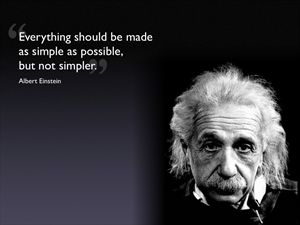What Is a Failure?
How do you feel about failure?
Oh, I know, it sucks. People feel bad about failure. They feel so bad about it that they tend not to think about it. They work hard to avoid having to admit to their failures. Sometimes they will work hard to coat themselves with imaginary Teflon so that their failures slide right off them and onto others. Some people work really hard to deny that failure exists.
But failure is all around. Failure exists. So how can people deny the existence of failure? It is all in the definition. It's in how you define failure.
I spoke about failure at the Warehouse Education and Research Council (WERC) meetings. I focused on the failure of start-up distribution operations, and the five failures that I consistently see in start-up operations. These problems don’t just happen in start-up operations, they appear in all sorts of established operations too. It is not rocket science — most experienced leaders know that not addressing these factors leads to greater failure.
A Failure to Define Victory
The most simplistic failure of all is the failure to define victory — and concomitant failure to define failure. Yin and Yang, Victory and Failure. You can’t have one without the other.
I remember asking a prospective client manager to define victory for a project. His answer was “Don’t fail.” He left that company before the end of the year.
You have to define both victory and failure. There is middle ground between them, a no-man’s land, a purgatory where so many operations lie, where CI (Continuous Improvement) teams toil away to increase productivity and reduce waste, making no real progress toward any real goal. I wish I could say that the continuum between victory and failure is binary, but the reality is a gray space of mediocrity, where the players in the field stumble back and forth in a fog, constantly moving the lines that define victory and failure. What is a victory in one set of eyes is a failure in another. Problems arise from not knowing which is which.
It is easy to reach for the middle. Safe. We hedge our bets, fudge our aim, and allow for windage. We make halfhearted pseudo-commitments, fingers crossed behind our backs. If we come close to the target, we are happy. If we hit the outer ring, we cheer. “Set reasonable expectations,” we’re told. “There has to be a balance,” say others. We compromise our goals so that the goals are not hard to reach, so easy that we don’t have to make an effort. Because we don’t work hard to reach our goals, we are willing to settle for something less.
What You Don’t Want
Years ago, as a young man, I stood at a crossroads. I really thought I wanted to be a journalist. I picked a college with a decent J-school and worked moderately hard in class. Some classes were kind of a bore, but the labs were fun. I loved working on the school paper. After finishing school, I went into the newspaper business and discovered that I did not like the people I worked with. I loved the work, but the people were a different story. So I moved to another paper. Same story. On to another paper, and the same thing. I realized that most people had mediocre talents and skills, at best. Most were hacks in the truest sense of the word. I hated their politics, and I hated their petty backbiting. I looked up and saw that there was no way these hacks were going to give anybody with talent and ambition a chance.
It came to a point that while I could not define good, I could define bad. While I could not define victory, I could define failure. I could draw a clear picture of the unacceptable — what was bad, what I did not want. I could see that the newsroom was no place for me.
The first step in defining victory is defining what is unacceptable. What is unacceptable defines failure. A leader defines what is acceptable, what is sufficient, and what is victory. There are three levels of success:
- Unacceptable — Do Not Go There.
- Sufficient — This is the minimum you must do.
- Victory — We get to sing our victory song.
Great leaders define all three, clearly. These definitions become the strategic promises the leader makes to the people he leads, and to the people he serves. Great leaders define all three, and repeat these definitions often, reminding the rest of the organization constantly of these three points.
Victors define victory before taking the field of battle. They determine what is sufficient to achieve that victory, and have more at the ready in case they miscalculate. They announce in advance what the reward is for doing the unacceptable.
The vanquished take the field of battle with insufficient thought. The vanquished enter the battle with their kits open, their troops misaligned. They quickly declare the sufficient level of effort to be victory, and then fight an ugly battle for defeat.
Winners first declare what is unacceptable, decide what is sufficient to begin, and commit to victory.
Most new distribution centers fail because the managers do not define the unacceptable. They miss that first step. They think that vigor and energy is sufficient to carry the day, and that sufficiency is success. These failures fail to declare victory.


